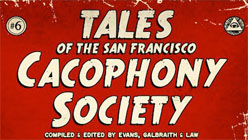A new book is out chronicling the history of the San Francisco Cacophony Society, a Dada-inspired art collective from the ’80s and ’90s that claims responsibility for the early organization of Burning Man, Chuck Palahniuk’s Fight Club, a performance art run for Mayor of San Francisco and a menagerie of other pranks pulled over the years. The society describes itself as “a randomly gathered network of free spirits in the pursuit of experiences beyond the pale of mainstream society.” What such vague language turned out to mean was something close to today’s flash mobs, large groups showing up in public spaces, often dressed in wild costumes, and participating in fun if not profoundly meaningful pranks and performances focused on deconstructing the supposed rationality of daily life and reveling in the absurd.
Tales of the San Francisco Cacophony Society is both a history text and a role call for the society’s leading members, all wrapped up in the visual texture of an early pop comic book. Besides the insultingly ablist line on the first page “they danced like Special Olympics,” the book is full of stories of absurdist happenings: a rain of giblets, a pilgrimage to Emperor Norton’s grave, and the day everyone spoke in tongues. These art parties sometimes took on sculptural form, such as toy store shelves seeded with cement filled teddy bears with tags printed with the chilling text: “Unfortunate child, do not mistake me for a living thing, nor seek in me the warmth denied you by your parents. For beneath my plush surface lies a hardness as impervious and unforgiving as this world’s own indifference to your mortal struggle. Hold on to me when you are sad, and I will weigh you down, but bear this weight throughout your years, and it will strengthen your limbs and harden your will so that one day no man dare oppose you.” This type of epic assertion was a common thread in the philosophy of the group.

With no claims at changing the world, the society’s stunts can hardly be judged ineffective, and they seem, at least looking back at them through the lens of the book, intentionally pointless. Why rappel off a cliff in formal attire while carrying an umbrella? Because you can; the pointlessness is the point — and the resulting visual will be amazing. The group’s events took on surrealistic subversion as a rallying ethos. In this light the book becomes not only a history text, but a menu of possible activities to recreate in your free time.



